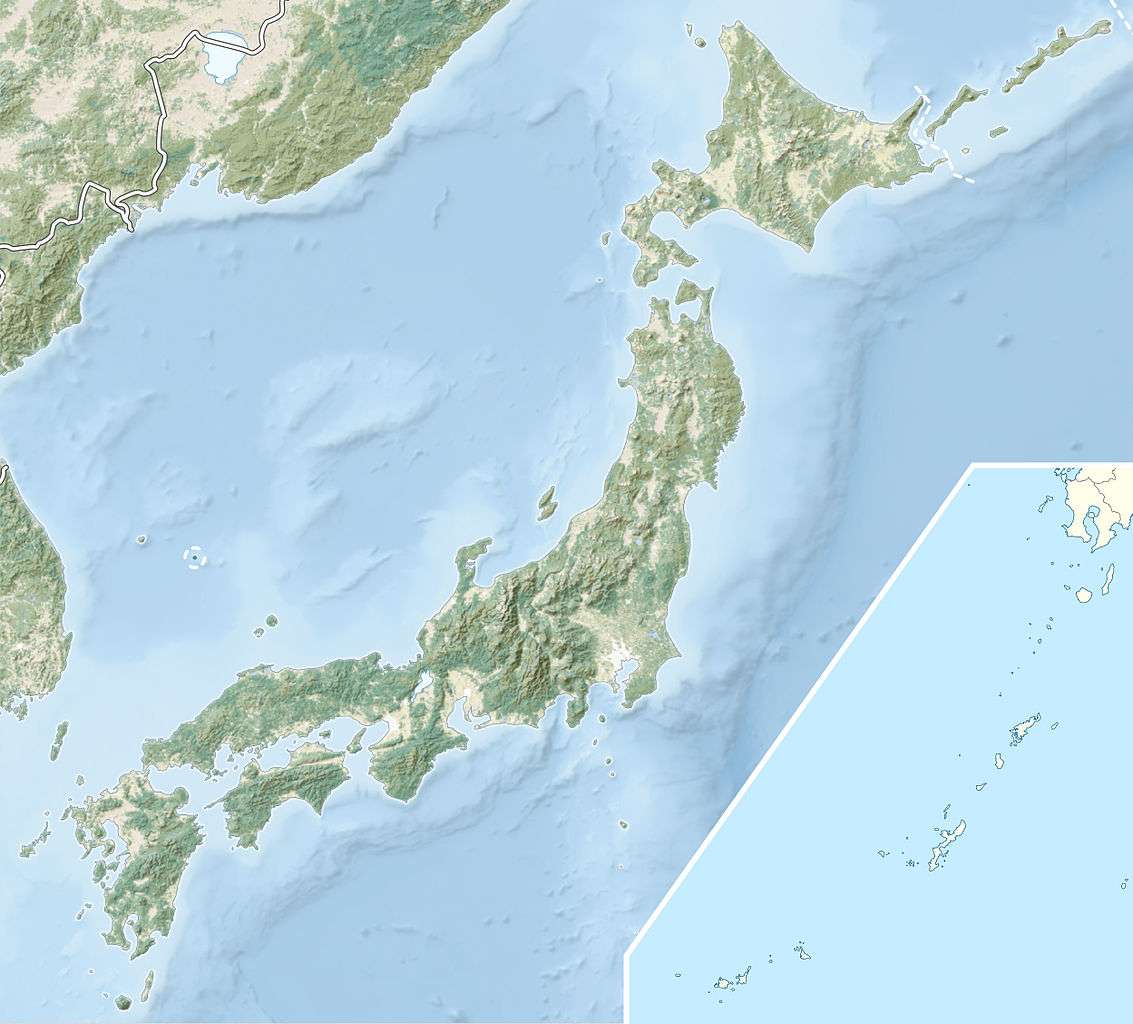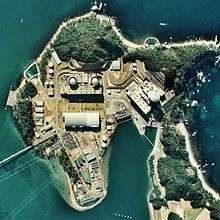Mihama Nuclear Power Plant
| Mihama Nuclear Power Plant | |
|---|---|
.jpg) Mihama Nuclear Power Plant | |
 Location of Mihama Nuclear Power Plant in Japan | |
| Country | Japan |
| Location | Mihama, Fukui Prefecture |
| Coordinates | 35°42′12.51″N 135°57′48.88″E / 35.7034750°N 135.9635778°ECoordinates: 35°42′12.51″N 135°57′48.88″E / 35.7034750°N 135.9635778°E |
| Status | Operational |
| Construction began | 1 February 1967 |
| Commission date | 28 November 1970 |
| Operator(s) | The Kansai Electric Power Company, Inc. |
| Power generation | |
| Units operational |
1 x 340 MW 1 x 500 MW 1 x 826 MW |
The Mihama Nuclear Power Plant (美浜発電所 Mihama hatsudensho, Mihama NPP) is operated by The Kansai Electric Power Company, Inc. and is in the town of Mihama, Fukui Prefecture, about 320 km west of Tokyo.[1] It is on a site that is 520,000 m2 of which 60% is green space.[2] Mihama - 1 was the first nuclear reactor to generate electricity commercially in Japan and was commissioned in 1970.[3]
Reactors on site
| Unit[4] | Reactor type | Average electric output | Electric power rating | Beginning of construction | First criticality | Commission date |
|---|---|---|---|---|---|---|
| Mihama - 1 | PWR | 320 MW | 340 MW | 01.02.1967 | 8 August 1970 | 28 November 1970 |
| Mihama - 2 | PWR | 470 MW | 500 MW | 29 May 1968 | 21 April 1972 | 25 July 1972 |
| Mihama - 3 | PWR | 780 MW | 826 MW | 07.08.1972 | 19 February 1976 | 01.12.1976 |
Events

The Mihama NPP has been notable beyond most nuclear plants due to the severity of accidents that have happened there, the 2004 steam explosion in particular.
February 9 1991
Unit 2 steam generator had one tube fully break. This triggered a SCRAM with full activation of the Emergency Core Cooling System. Eventually, a small amount of radiation was released to the outside.
17 May 2003
Unit 2 steam generators had two holes open simultaneously. There was no radioactive release to the environment.
9 August 2004
On 9 August 2004, an accident occurred in a building housing turbines for the Mihama 3 reactor.[1] Hot water and steam leaking from a broken pipe killed five workers and resulted in six others being injured.[1][5][6] The accident had been called Japan's worst nuclear power accident[7][8] before the crisis at Fukushima I Nuclear Power Plant.[9]
The Mihama 3 is an 826 megawatts electric, 3-loop Westinghouse type pressurized water reactor (PWR) which has been in service since 1976. The pipe rupture occurred in a 55.9 centimeter (cm) (22 inch) outside diameter pipe in the ‘A’ loop condensate system between the fourth feedwater heater and the deaerator, downstream of an orifice for measuring single-phase water flow. At the time of the secondary piping rupture, 105 workers were preparing for periodic inspections to commence.[10]
A review of plant parameters did not uncover any precursor indicators before the accident nor were there any special operations that could have caused the pipe rupture. An investigation concluded that water quality had been maintained since the commissioning of the plant, however the failing pipe had been omitted from an initial inspection plan and quality management systems were ineffective.[10]
Japan's previous most deadly accident at a nuclear facility took place at a uranium processing plant in Tokaimura, north of Tokyo, on 30 September 1999, when an uncontrolled nuclear chain reaction was triggered after three poorly trained workers add too much uranium solution to a precipitation tank. The resulting release of radiation killed two workers, and exposed one other worker to radiation above legal limits.[11]
Mihama-3 restarted in January 2007 after making changes to "reestablish a safety culture" within KEPCO and obtaining permission from Fukui Prefecture and industry regulators.[12]
2006
Another fire occurred in 2006, two workers sustained injuries. There were no fatalities and no release of radioactivity detected, though the ash involved in the fire included some low level radioactive waste.
Juridical actions against restarting nuclear powerplants
In August 2011 citizens of the prefecture Shiga, at the banks of Lake Biwa, started a lawsuit at the Otsu District Court, and asked a court order to prevent the restart of seven reactors operated by Kansai Electric Power Company, in the prefecture Fukui.[13]
Seismic research in 2011 and 2012
On 5 March 2012 a group of seismic researchers revealed the possibility of a 7.4M (or even more potent) earthquake under the Tsuruga Nuclear Power Plant. Before this date the Japanese governmental Earthquake Research Committee and Japan Atomic Power had calculated that the Urasoko fault under the plant, combined with other faults connected to it, was around 25 km long. and could cause a 7.2M quake and a 1.7 meter displacement. On top of this, the presence of the oceanic faults were not taken into account by NISA and JAP in the assessment of the safety of the Tsuruga nuclear power plant.
Analysis of sonic survey and other data provided by Japan Atomic Power analysed by a panel of experts of the Nuclear and Industrial Safety Agency showed the presence of multiple faults existing within 2 to 3 km from the Urasoko fault. According to Sugiyama, a member of this group of scientists, these faults were highly likely to be activated together, and this would extend the length of the Urasoko fault to 35 km.
Computer simulations calculating the length of a fault based on its displacement showed the Urasoko fault to be 39 km long, a result close to the length estimated by the sonic survey data, and the fault could cause some five meters of displacement when activated together with other faults.
Yuichi Sugiyama, the leader of this research group of the National Institute of Advanced Industrial Science and Technology, warned that, as other faults on the south side of the Urasoko fault could become activated together, "The worst-case scenario should be taken into consideration."
According to the experts there were many other faults located under one reactor on the west side of the Urasoku fault that could move also simultaneously. If this were confirmed, the location of the Tsuruga nuclear plant would be disqualified.[14]
On 6 March 2012 NISA asked Japan Atomic Power Co. to reassess the worst-case scenario for earthquakes at the Tsuruga Nuclear Power Plant. They were to find out what damage this could do to the buildings on the site, because the Urazoko fault, running around 250 meters from the reactor buildings, could have a serious impact on the earthquake resistance of the power plant. NISA was also planning to send similar instructions to two other nuclear power plant operators in the Fukui area: Kansai Electric Power Company, and Japan Atomic Energy Agency. The Mihama Nuclear Power Plant and the Monju fast-breeder reactor could also be affected by a possible earthquake caused by the Urazoko fault.[15]
Unit 1 and unit 2 shutdown
Regulation brought in after the March 2011 nuclear disaster forbids the operation of nuclear reactors for more than 40 years. Operators could secure a 20-year operation extension from the Nuclear Regulation Authority if the reactors are refitted, but Kansai Electric believed that it was not economical to invest in costly refits for the two older units, Nos. 1 and 2 reactors, given the comparatively small output. For example, the new regulations require utilities to install power cables made from fire-retardant materials. So, the company has decided to scrap units Mihama 1 and Mihama 2.[16]
Unit 3 life extension to 60 years
Japan's nuclear regulator approved an application to extend the life of Unit 3 beyond 40 years, the second such approval granted since the Fukushima disaster. The move means Kansai Electric can keep Unit 3 operating until 2036. Unit 3 would turn 40 years old in December 2016. Restart will happen after safety upgrades are completed by March 2020 and will cost about 165 billion yen ($1.51 billion). The upgrades involve fire proofing cabling and other measures.[17]
References
- 1 2 3 Four killed in nuclear plant accident
- ↑ Kepco (Japanese). Mihama Overview.
- ↑ "A Japanese 'first' on nuclear power, Mihama (1970) - on Newspapers.com". Newspapers.com. Retrieved 2015-08-09.
- ↑ Power Reactor Information System der IAEA: „Japan: Nuclear Power Reactors"
- ↑ Press release from KEPCO (English)
- ↑ Mihama Nuclear Power Plant Accident
- ↑ Japan's shaky nuclear record
- ↑ Japanese utility to shut reactor after admitting accident cover-up
- ↑ Japan crisis: third explosion raises spectre of nuclear nightmare
- 1 2 Secondary piping rupture at the Mihama Power Station in Japan
- ↑ Tokaimura Criticality Accident at World Nuclear Association
- ↑ "Restarting Commercial Operation of Mihama Nuclear Power Plant Unit 3". KEPCO. 7 February 2007. Retrieved 16 April 2014.
- ↑ The Mainichi Daily News (9 November 2011) Residents seek court order not to restart Tsuruga reactors
- ↑ The Mainichi Shimbun (5 March 2012)Fault under Tsuruga nuclear plant could trigger M7.4 quake: research
- ↑ The Mainichi Shimbun (7 March 2012) Quake severity estimate for Tsuruga nuclear plant to be reassessed
- ↑ "Life-span extension reviews begins for three aging Kepco reactors". The Japan Times Ltd. 2 April 2015. Retrieved 3 April 2015.
- ↑ "Japan agrees second nuclear reactor life extension since Fukushima". Reuters. 16 November 2016. Retrieved 22 November 2016.
External links
| Wikimedia Commons has media related to Mihama Nuclear Power Plant. |
- Mihama Nuclear Power Plant (Japanese)
- Japanese nuclear operator to shut 11 plants
- Worst Japanese Nuclear Accident Claims Fifth Life
- BBC News Report on the Steam Accident